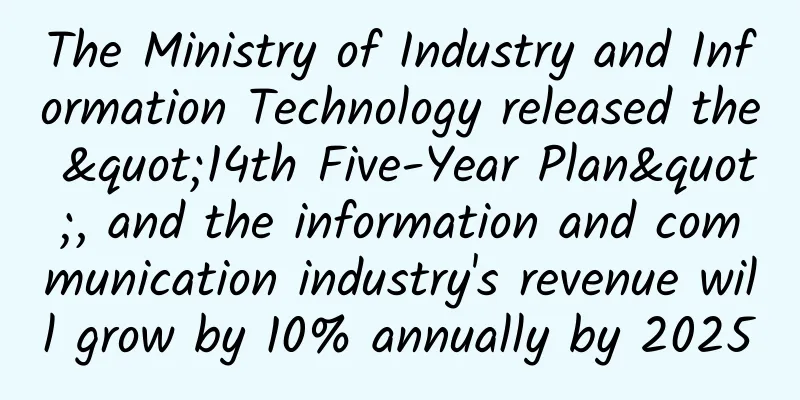The Ministry of Industry and Information Technology released the "14th Five-Year Plan", and the information and communication industry's revenue will grow by 10% annually by 2025

|
On November 16, the Ministry of Industry and Information Technology issued the "14th Five-Year Plan for the Development of the Information and Communications Industry" (hereinafter referred to as the "Plan"). The "Plan" defines the main development goals of my country's information and communications industry during the "14th Five-Year Plan" period. The "Plan" points out that during the 13th Five-Year Plan period, the revenue scale of the information and communication industry will grow steadily, reaching 2.64 trillion yuan in 2020, with an average annual growth of 9.1%; network supply and service capabilities will be significantly enhanced, the proportion of administrative villages with fiber optic and 4G access will exceed 99%, and the number of national-level Internet backbone direct connection points will increase to 14; security assurance capabilities will continue to increase, the comprehensive strength of the network security industry will increase rapidly, and the industry scale will exceed 170 billion yuan.
Regarding the specific indicators during the 14th Five-Year Plan period, the "Plan" clearly states that from 2020 to 2025, the revenue of the information and communication industry will increase from 2.64 trillion yuan to 4.3 trillion yuan; the number of 5G base stations per 10,000 people will increase from 5 to 26; the proportion of mobile network IPv6 traffic will increase from 17.2% to 70%; the 5G user penetration rate will increase from 15% to 56%; the 5G accessibility rate of administrative villages will increase from 0 to 80%, etc. The Plan also mentioned in its development priorities that it is necessary to build a new type of digital infrastructure. It is necessary to accelerate the construction of "dual gigabit" networks, coordinate the layout of data centers, actively and steadily develop the industrial Internet and the Internet of Vehicles, and build a new digital infrastructure system driven by technological innovation, based on a new generation of communication networks, with data and computing facilities as the core, and with integrated infrastructure as a breakthrough. Regarding the main development goals, the Plan elaborates on the following seven items. 1. The communication network infrastructure maintains the international advanced level. The world's largest 5G independent networking network has been built, achieving full coverage of cities and towns, basic coverage of administrative villages, and deep coverage of key application scenarios; the gigabit fiber network achieves basic coverage of urban and rural areas. The level of intelligent resource scheduling of the backbone network has been significantly improved, the interconnection architecture has been continuously optimized, the overall performance has remained world-class, and the network, platform, application, terminal, etc. fully support IPv6. A comprehensive mobile Internet of Things ecosystem with coordinated development of low, medium and high speeds has been fully formed. The layout of the international communication network is more balanced, and the network quality and service capabilities have been significantly improved. 2. The service capabilities of data and computing facilities have been significantly enhanced. The layout of data centers has achieved coordinated development in the east, middle and west, and the level of intensive and large-scale development has been significantly improved, forming a multi-level computing facility system with data-network collaboration, data-cloud collaboration, cloud-edge collaboration, and green intelligence. The computing power level has been greatly improved, and the service capabilities of artificial intelligence, blockchain and other facilities have been significantly enhanced. 3. Achieve key breakthroughs in integrated infrastructure construction. Basically build a high-quality industrial Internet network covering all regions and industries, and create a number of "5G+Industrial Internet" benchmarks. The industrial Internet identification resolution system is more complete, and service capabilities are greatly improved. Build a number of influential industrial Internet platforms and public service platforms. Achieve large-scale coverage of cellular vehicle-to-everything (C-V2X) on key highways and urban roads. 4. The level of digital application has been greatly improved. Information and communication technology has been deeply integrated with various fields of the economy and society, and the level of data application in the industrial and information and communication fields has been significantly improved. New Internet formats and models have flourished, and the scope of innovative applications of the industrial Internet has continued to extend to the core links of production and manufacturing. The number of companies on the cloud and platform has increased significantly, and the level of digitalization and intelligence of social governance and public services has been significantly improved. The collaborative innovation ecosystem has been further optimized, and a number of distinctive and specialized companies have been cultivated in the links of terminal, content and application development. 5. The ability to govern the industry and protect user rights has leapt forward. The ability to "manage the network with the network and link the whole network" has been basically formed, the basic management and market supervision capabilities have been comprehensively enhanced, the network operation, emergency support, and industry service levels have been comprehensively improved, and a new industry supervision system has been initially established. The regulatory policy and standard system has been further improved, the local regulatory capacity has been further strengthened, the ability to protect user rights has been significantly improved, the protection of user personal information has been continuously strengthened, the channels for user expression of demands, interest coordination, and rights protection are unobstructed, and the response is timely. The protection of the rights and interests of Internet and telecommunications users is effective and effective. 6. Effectively improve network and data security assurance capabilities. The security assurance system of key information infrastructure in the industry is more sound, the integrated security assurance capabilities of new digital infrastructure are significantly enhanced, and the network data security governance capabilities are significantly improved. The mechanism for preventing and resolving major network security risks is more effective, and the emergency response to sudden security incidents and the network security and communication assurance levels of major events have been significantly improved. The network security industry is more powerful, and the innovation capability and supply level have been effectively improved. 7. The level of green development has reached a new level. New technologies, new equipment and new energy sources for energy conservation and emission reduction are widely used, the level of structural and systematic energy conservation innovation has been significantly improved, and the comprehensive energy consumption per unit of total telecommunications business has further decreased. Information and communication technology has enabled energy conservation and emission reduction in various fields of society to achieve remarkable results and play an important role in promoting green development of the economy and society. Regarding this "Plan", Hu Jianbo, deputy director of the China Academy of Information and Communications Technology, said that compared with previous five-year plans, this "Plan" further highlights the function and positioning of the information and communication industry, adapts to the new situation of the expansion of the connotation and structural changes of the information and communication industry, and firmly grasps the theme of high-quality development. The content presents the following highlights: First, the connotation and scope of the "Plan" show a trend of continuous expansion compared with the "13th Five-Year Plan"; second, the "Plan" systematically summarizes the remarkable achievements made in the development of the industry, and also sorts out some shortcomings that still exist at this stage; third, the "Plan" summarizes the new situation facing the industry in the "14th Five-Year Plan", and believes that opportunities still outweigh challenges; fourth, the "Plan" establishes new ideas and basic principles for high-quality development of the industry; fifth, the "Plan" systematically sorts out the quantitative goals of industry development, and among the 20 proposed quantitative goals, the "new infrastructure" related indicators account for a relatively high proportion; sixth, the "Plan" aims at development goals and focuses on problems and shortcomings, and proposes 26 key directions for industry development and management during the "14th Five-Year Plan" period from five aspects: new digital infrastructure, digital development, industry management, security, and cross-regional and cross-industry coordination. |
<<: Is HTTP1.1 Keep-Alive considered a long connection?
>>: 5G is here, how far is 6G?
Recommend
5G and IoT: Compatible with each other
5G is here! It’s hard to ignore the hype surround...
What is Far-End Crosstalk and Near-End Crosstalk
If you are at all familiar with copper cable test...
Verizon launches 5G private network in the United States and officially launches commercial use
Verizon Business recently launched its first comm...
You know IPv4, but how much do you know about the new IPv6?
According to Google user statistics, as of June t...
The 5G commercial era is coming, and large-scale commercial use will be achieved in 2020
The Ministry of Industry and Information Technolo...
The Ministry of Industry and Information Technology stated: Promote the development of dual-gigabit networks represented by 5G and optical fiber
China has made some achievements in 5G developmen...
Enterprises need to have six capabilities to achieve digital transformation
As we step into the 21st century, the wave of dig...
Why TCP will be replaced by UDP
Why's THE Design is a series of articles abou...
Let's talk about the time-consuming TCP connection
When developing daily interfaces on the Internet ...
Blockchain subverts the underlying architecture of the financial industry and opens a new era of value interconnection
Blockchain is essentially a decentralized databas...
Bloomberg: China is winning the multi-trillion dollar war for 5G
The coronavirus has not slowed down China’s stead...
Strategy Analytics: 5G continues to grow rapidly despite component shortages
On June 2, according to the latest report release...
"Smart Travel" in Linzhi, Tibet, during the summer vacation, Wi-Fi has been widely used in WeChat Moments
During the summer vacation, as a hot spot in the ...
Why are operators collectively canceling “unlimited data” packages?
China Telecom announced that it will stop selling...
RAKsmart: Korean server/Japanese server starting from $59/month, 50-300M mainland optimized bandwidth
RAKsmart's October promotion has begun, and a...









